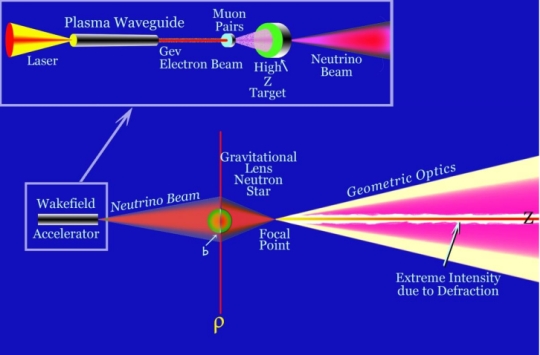If you want to look for possible artifacts of advanced civilizations, as do those practicing what is now being called Dysonian SETI, then it pays to listen to the father of the field. My friend Al Jackson has done so and offers a Dyson quote to lead off his new paper: “So the first rule of my game is: think of the biggest possible artificial activities with limits set only by the laws of physics and look for those.” Dyson wrote that in a 1966 paper that repays study today (citation below). Its title: The Search for Extraterrestrial Technology.” Dysonian SETI is a big, brawny zone where speculation is coin of the realm and the imagination is encouraged to be pushed to the limit.
Jackson is intrigued, as are so many of us, with the idea of using the Sun’s gravitational lens to make observations of other stars and their planets. Our recent email conversation brought up the name of Von Eshleman, the Stanford electrical engineer and pioneer in planetary and radio sciences who died two years ago in Palo Alto at 93. Eshleman was writing about gravitational lensing possibilities at a time when we had no technologies that could take us to 550 AU and beyond, the area where lensing effects begin to be felt, but he saw that an instrument there could make observations of objects directly behind the Sun as their light was focused by it.
Claudio Maccone has been working this terrain for a long time, and the complete concept is laid out in his seminal Deep Space Flight and Communications: Exploiting the Sun as a Gravitational Lens (Springer Praxis, 2009). There is much to be said about lensing and space missions, and it’s heartening to see interest in scientists within the Breakthrough Starshot project — a sail moving at 20 percent of lightspeed gets us to 550 AU and beyond relatively quickly. By my back of the envelope figuring, travel time is just a little short of 16 days.
There would be no need for Starshot to approach 550 AU at 20 percent of c, of course. The focal line runs to infinity, but as Jackson explains when running through gravitational lensing’s calculations, we can assume beam intensity gradually diminished by absorption in the interstellar medium, though all of this with little beam divergence. Just how to use the Sun’s gravity lens (a relay for returning data from a star mission, I assume) and how to configure mission parameters to get to the lensing region and use it are under debate.
Transmitting Through a Gravitational Lens
But back to Al Jackson’s paper, which offers us a take on gravitational lensing that I have never before encountered [see my addendum at the end of this post for a correction]. What he is proposing is that an advanced civilization of the kind Dyson is interested in would have the capability of using a gravitational lens to transmit data. He’s turned the process around, from observation to beacon or other form of communication. And he’s working with neutrinos, where attenuation from the interstellar medium is negligible.
A gravitational lens does not, of course, need to be a star, but could be a higher mass object like a neutron star. In Jackson’s thinking, a KII civilization could place a neutrino beam transmitting station around a neutron star. We make neutrino beams today via the decay of pi mesons, as the author reminds us, when large accelerators boost protons to relativistic energies that strike a target, producing pions and kaons that decay into neutrinos, electrons and muons. What counts for Jackson’s purposes is that pions and kaons can be focused to produce a beam of neutrinos.
For a stellar mass gravitational lens and 1 Gev neutrinos, the wavelength is about 10-14 cm, the gain is approximately 1020! The characteristic radius of main region of concertation is about one micron; however there is an effective flux out to about one centimeter.
And as mentioned above:
This beam intensity extends to infinity only diminished by absorption in the interstellar medium, encounters with a massive object like a planet or star and a very small beam divergence.

Image: This is Figure 6 from the paper. Caption: A schematic illustration of a possible neutrino accelerator-transmitter, the accelerator and lens (nothing to scale). Credit: A. A. Jackson.
A one-centimeter beam creates the problem of focusing on a specific target, one whose phenomenal pointing accuracy could only be left to our putative advanced civilization. Even so, increase the number of transmitters and detection becomes easier. Thus Jackson:
Suppose that a K2 type civilization capable of interstellar flight can reach a neutron star it should have the technological capability to build a beacon consisting of an array of transmitters in a constellation of orbits about the neutron star. Let this constellation consist of 1018 ‘neutrino’ transmitters 1 meter in characteristic size ‘covering’ the area of a sphere 1000 km in radius with 1018 particle accelerators in orbit… At the present time there is the development of plasma Wakefield particle accelerators that are meters in size [21, 22]. It is probable that a K2 civilization may construct Wakefield electron accelerators of very small size.
Jackson has heeded Dyson, that’s for sure. Remember the latter’s injunction: “…think of the biggest possible artificial activities with limits set only by the laws of physics and look for those.”
What emerges is a ‘constellation of neutrino beam transmitters,’ 1018 in orbit at 1000 neutron star radii, increasing the probability of detection, so that the detection rate at 10,000 light years becomes approximately 5 per minute. The transmitters must be configured to appear as point sources to the gravitational lens, again another leap demanding KII levels of performance. But if a civilization is trying to be noticed, a neutrino beam that takes neutrino detection well out of the range produced through stellar events in the galaxy should stand out.
Thus we have a method for producing directed neutrino signal transmission. Why come up with such? Harking back to Dyson, we can consider the need to examine the range of possible ETI technologies, hoping to create a catalog that could explain future anomalous observations. Jackson’s beam could be used as what he calls a ‘honey pot’ to attract attention to an electromagnetic transmitter broadcasting more sophisticated information. But we would not necessarily be able to understand what uses an advanced civilization would make of such capabilities. We might have to content ourselves merely with the possibility of observing them.
As Jackson points out, a KII civilization “…would likely have the resources to finesse the technology in a smarter way,” so what we have here is a demonstration that a thing may be possible, while we are left to wonder in what other ways a neutrino source can be used to produce detections at cosmic distances. Going deep to speculate on technologies far beyond our reach today should, as Dyson says, remind us to stay within the realm of known physics while simultaneously asking about phenomena that advanced engineering could produce. We hope through the labors of Dysonian SETI to recognize such signatures if we see them.
Appreciating Von Eshleman
And a digression: When Al brought up Von Eshleman in our conversations, I began thinking back to early gravitational lensing work and Eshleman’s paper, written back in 1979 but prescient, surely, of what was to come in the form of serious examination of lensing capabilities for space missions. Let me quote Eshleman’s conclusion from the paper, cited below. I have a lot more to say about Eshleman’s work, but let’s get into that at another time. For now:
It has been pointed out that radio, television, radar, microwave link, and other terrestrial transmissions are expanding into space at 1 light-year per year (2). Another technological society near a neighboring star could receive the strongest of these directly with substantial effort and could learn a great deal about the earth and the technology of its inhabitants. The concepts presented here suggest that on an imaginary screen sufficiently far behind that star, the short-wavelength end of this terrestrial activity is now being played out at substantial amplifications. Properly placed receivers with antennas of modest size could in principle scan the earth and discriminate between different sources, mapping such activity over the earth and learning not only about the technology of its inhabitants, but also about their thoughts. It is possible that several or many such focused stories about other worlds are now running their course on such a gigantic screen surrounding our sun, but no one in this theater is observing them…
I learned about Eshleman’s work originally through Claudio Maccone and often reflect on the tenacity of ideas as we go from a concept originally suggested by Einstein to a SETI opportunity realized by Eshleman to a mission concept detailed by Maccone, and now a potential actual mission seriously discussing using gravitational lensing as a relay opportunity for data return from Proxima Centauri (Breakthrough Starshot). As it always has, the interstellar field demands long-term thinking that crosses generations in support of a breathtaking goal.
[Addendum]: Although I hadn’t heard of discussions on using gravitational lensing for transmission, an email just now from Clément Vidal points out that both Claudio Maccone and Vidal himself have looked into this. In Clément’s case, the reference is Vidal, C. 2011, “Black Holes: Attractors for Intelligence?” at Towards a scientific and societal agenda on extra-terrestrial life, 4-5 Oct, Buckinghamshire, Kavli Royal Society International Centre. Abstract here. This quote is to the point:
“For a few decades, researchers have proposed to use the Sun as a gravitational lens. At 22.45AU and 29.59AU we have a focus for gravitational waves and neutrinos. Starting from 550AU, electromagnetic waves converge. Those focus regions offer one of the greatest opportunity for astronomy and astrophysics, offering gains from 2 to 9 orders of magnitude compared to Earth-based telescopes…It is also worth noting that such gravitational lensing could also be used for communication…Indeed, it is easy to extrapolate the maximal capacity of gravitational lensing using, instead of the Sun, a much more massive object, i.e. a neutron star or a black hole. This would probably constitute the most powerful possible telescope. This possibility was envisioned -yet not developed- by Von Eshleman in (1991). Since objects observed by gravitational lensing must be aligned, we can imagine an additional dilating and contracting focal sphere or artificial swarm around a black hole, thereby observing the universe in all directions and depths.”
The author of The Beginning and the End: The Meaning of Life in a Cosmological Perspective (2014), Vidal’s thinking is examined in The Zen of SETI and elsewhere in the archives.
I’m glad Clément wrote, especially as it jogged my memory about Claudio Maccone’s paper on using lenses as a communications tool, where the possibilities are striking. See The Gravitational Lens and Communications for more. I wrote about this back in 2009 and thus have no good excuse for letting it slip my mind!
The paper is Jackson, “A Neutrino Beacon” (preprint). The Dyson paper is “The Search for Extraterrestrial Technology,” in Marshak, ed. Perspectives in Modern Physics: Essays in Honor of Hans Bethe, New York: John Wiley & Sons 1966. The Eshleman paper is “Gravitational Lens of the Sun: Its Potential for Observations and Communications over Interstellar Distances,” Science Vol. 205 (14 September 1979), pp. 1133-1135 (abstract).

